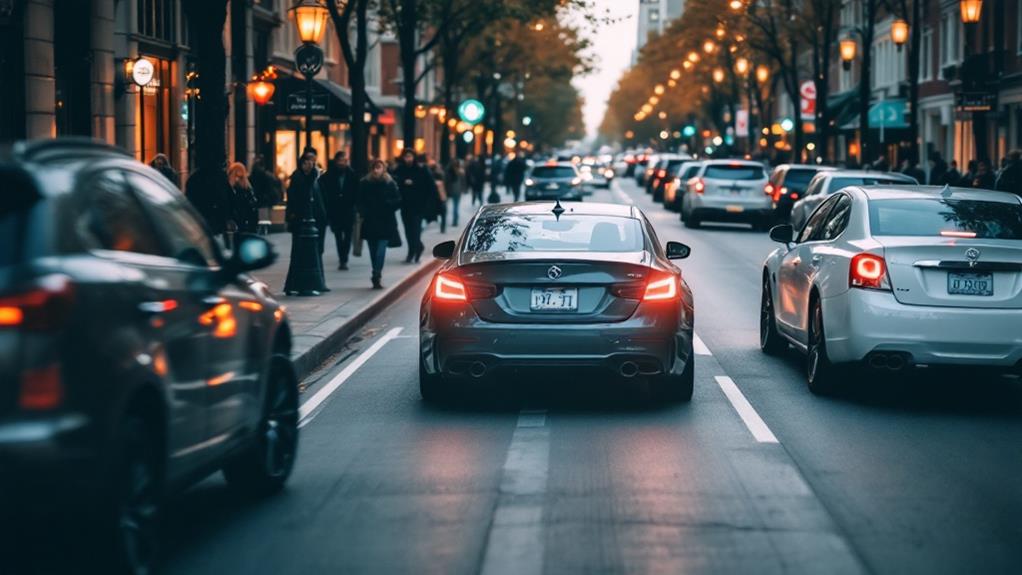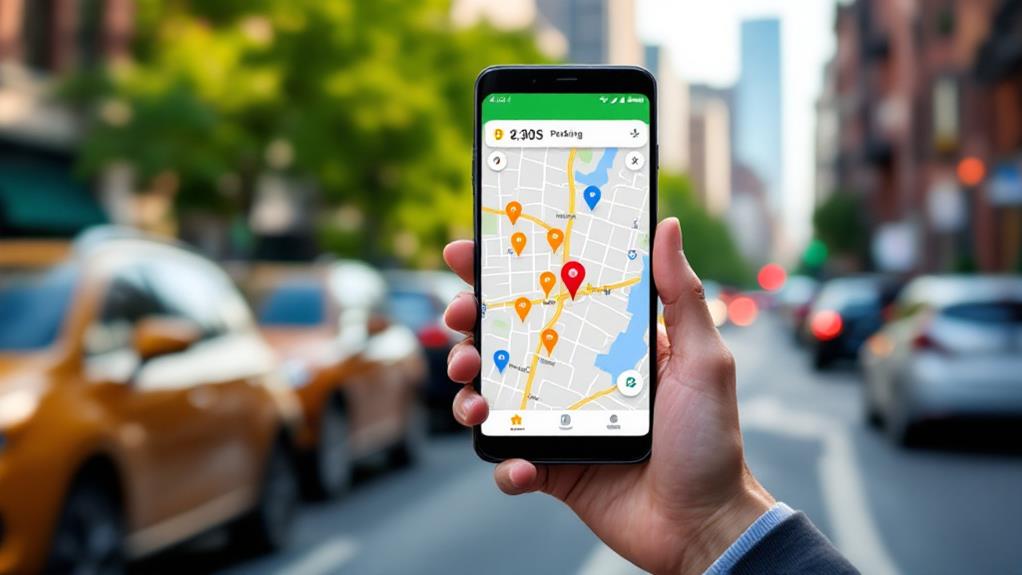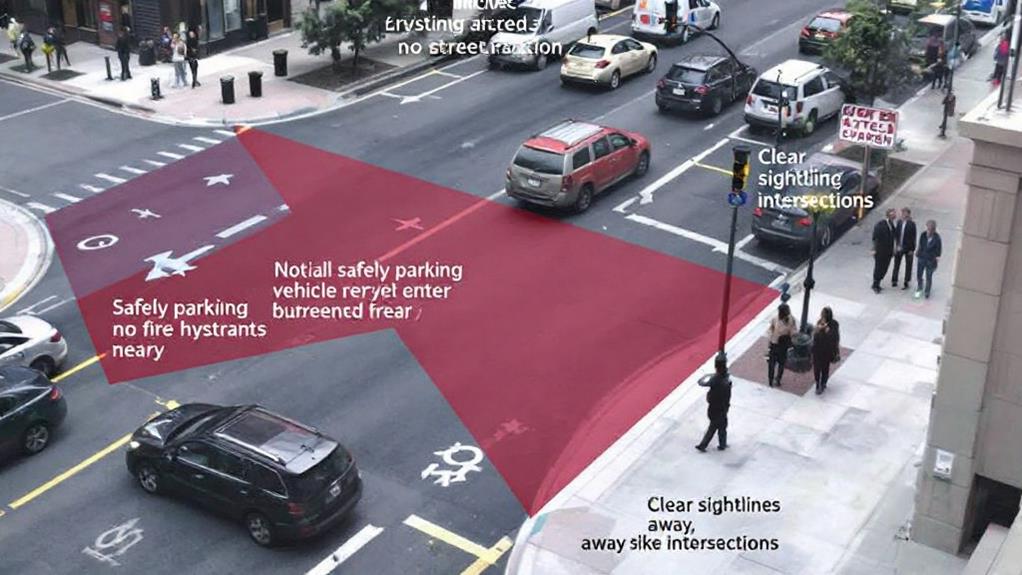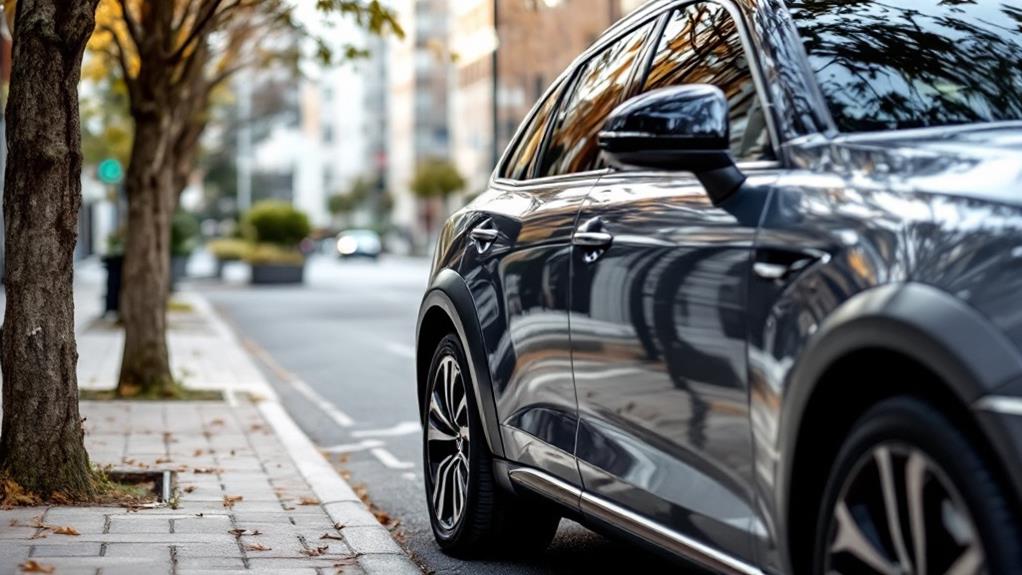Street Parking Etiquette: What Every Driver Should Know
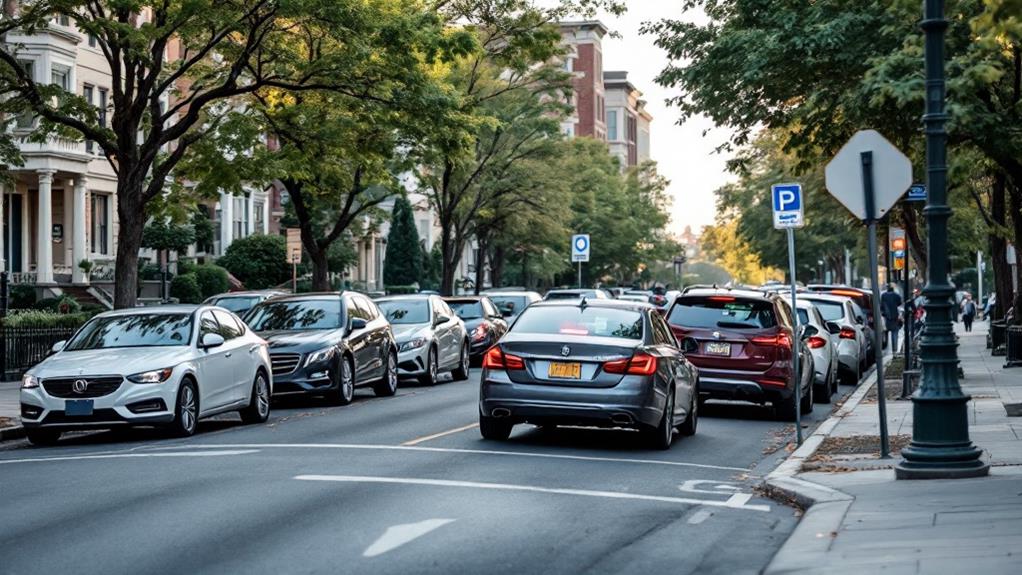
Street parking etiquette is essential for maintaining harmony in urban areas. You should always signal your intentions clearly, using turn signals or hazard lights when appropriate. Position your vehicle correctly within designated spaces, respecting other drivers' room to maneuver. Be mindful of parking signs and time limits to avoid tickets. Choose safe, well-lit locations and take measures to safeguard your vehicle. When exiting, check your surroundings carefully and merge smoothly with traffic. Remember to be considerate of pedestrians and handle any disputes gracefully. Commanding these unwritten rules will make you a more courteous and efficient street parker, enhancing everyone's urban driving experience.
Signaling Your Parking Intentions
When approaching a potential parking spot, it's crucial to signal your intentions clearly to other drivers. Use your turn signal well in advance to indicate you're planning to park. This gives other motorists time to adjust their speed and position, preventing confusion and potential accidents.
If you're waiting for a parking spot to become available, activate your hazard lights. This alerts others that you're temporarily stopped and intend to park soon. As you wait, position your vehicle slightly away from the spot to allow traffic to flow around you.
Make eye contact with other drivers when possible, especially if there's competition for the same spot. A quick nod or wave can help establish who has priority. If someone else was waiting first, it's courteous to yield the spot to them.
When you see a car leaving a parking space, don't block traffic by stopping abruptly. Instead, pull up alongside the departing vehicle if possible, keeping your turn signal on. This allows other drivers to understand your intentions while maintaining traffic flow.
Positioning Your Vehicle Correctly
Once you've successfully signaled your intentions and secured a parking spot, proper positioning becomes the next key focus. As you prepare to park, align your vehicle parallel to the curb, leaving about 6-12 inches between your tires and the curb edge. This distance guarantees you're close enough to the curb without risking damage to your wheels.
When positioning your vehicle within the space, make sure you're centered between any painted lines or other parked cars. If there are no clear markings, leave equal room on both ends of your car. This considerate approach allows for easy entry and exit for neighboring vehicles.
Be mindful of the overall space you're occupying. If possible, leave room for another car to park in front of or behind you. This maximizes the available parking for everyone on the street. In tight spaces, it's courteous to pull forward or back up as much as possible to create more room.
Remember to turn your wheels towards the curb when parking on a hill, and always engage your parking brake. These steps prevent your vehicle from rolling and potentially causing damage or blocking traffic.
Respecting Other Drivers' Space
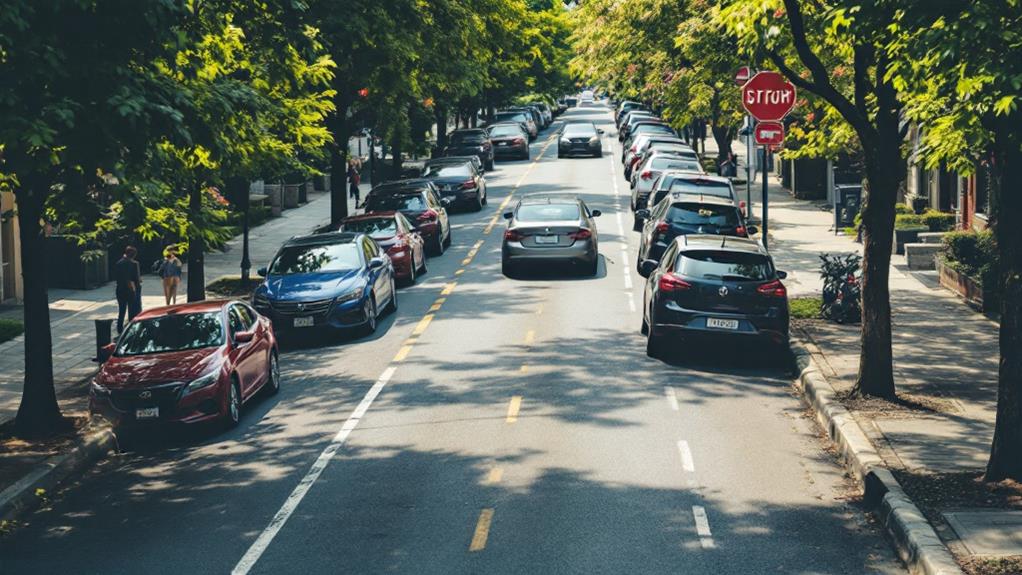
Considering the limited space available in urban areas, respecting other drivers' parking needs is essential for harmonious street parking. When you park your vehicle, make sure it's centered within the marked lines of the parking space. This consideration allows other drivers to comfortably open their car doors without risking damage to either vehicle.
Be mindful of how you position your car in relation to others. Avoid parking too far forward or backward, as this can restrict access to neighboring vehicles. Remember that larger vehicles, such as SUVs or trucks, require more room to maneuver in and out of parking spaces.
To maintain a courteous parking environment:
- Park within designated lines, avoiding straddling multiple spots
- Leave ample space for adjacent vehicles to open doors
- Position your car to allow easy entry and exit for others
In both street parking and parking lots, it's critical to be aware of your vehicle's impact on traffic flow. Don't block other drivers or impede the smooth movement of vehicles. By respecting another driver's space and following these guidelines, you contribute to a more efficient and stress-free parking experience for everyone.
Reading and Following Parking Signs
In order to park legally and avoid tickets, you'll need to command the art of reading and following parking signs. Start by carefully examining all posted signs in the area where you intend to park. These signs contain pivotal information about parking time limits and prohibited zones.
Pay close attention to any permit requirements indicated on the parking signs. Some areas may be restricted to residents or require specific permits during certain hours. Don't overlook signs designating loading zones, disabled parking, or other specialized parking spaces. You'll want to make certain you're not inadvertently parking in a restricted area.
Be aware of any special event or tow-away zone restrictions displayed on parking signs. These temporary changes can catch you off guard if you're not vigilant. Additionally, familiarize yourself with parking meter or mobile payment instructions listed on nearby signage. Understanding how to pay for your parking is essential to avoid fines.
Choosing Safe Parking Locations
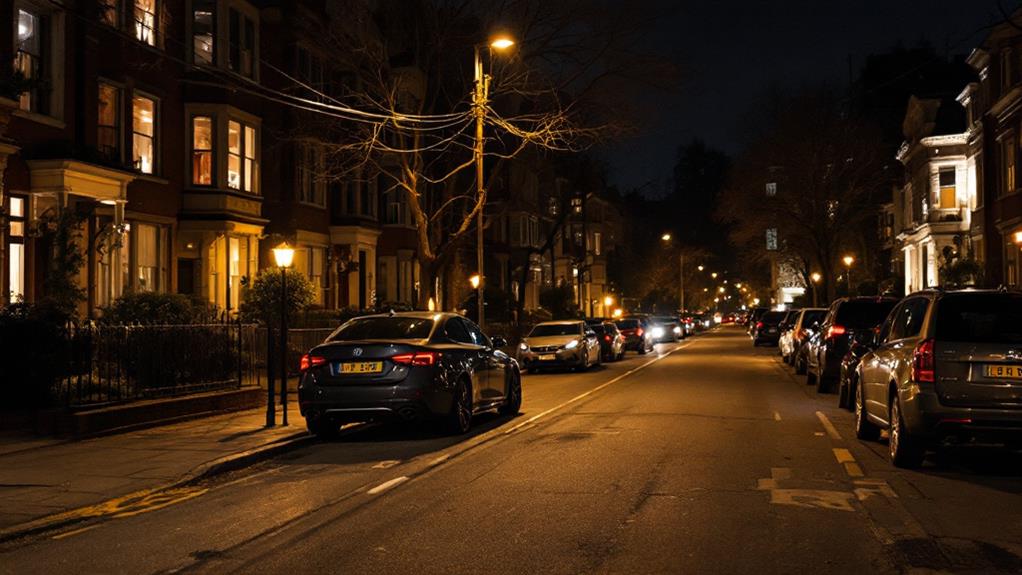
After conquering the art of reading parking signs, you'll want to focus on selecting safe parking locations. When choosing a spot for your car, prioritize well-lit areas to deter potential theft or vandalism. This simple step can greatly increase your vehicle's security while parked on the street.
Avoid parking under trees to protect your car from sap, bird droppings, and falling branches. These natural hazards can cause damage to your vehicle's exterior. Instead, opt for corner spots whenever possible. This strategy minimizes the risk of getting blocked in by another car and provides easier maneuverability.
When selecting a parking spot, consider the following:
- Choose spaces that allow for easy entry and exit
- Guarantee good visibility of the surroundings
- Be aware of any signage indicating prohibited zones or permit requirements
Parallel Parking Techniques
Commanding parallel parking can metamorphose a formidable task into a seamless, effortless maneuver. Even in a busy parking lot, you can confidently park your car by following a few key techniques. Start by positioning your vehicle parallel to the car in front of your desired spot, maintaining about 2-3 feet of space between you. As you begin to back up, sharply turn your steering wheel towards the curb when your rear starts swinging into the spot.
Once your vehicle's rear has cleared the car in front, straighten your wheels and continue reversing into the space. Take the time to adjust your position, ensuring you're centered within the marked lines and close to the curb. Throughout the process, use your mirrors and rear window vision to guide your movements, making small steering adjustments as needed.
Safeguarding Your Parked Vehicle
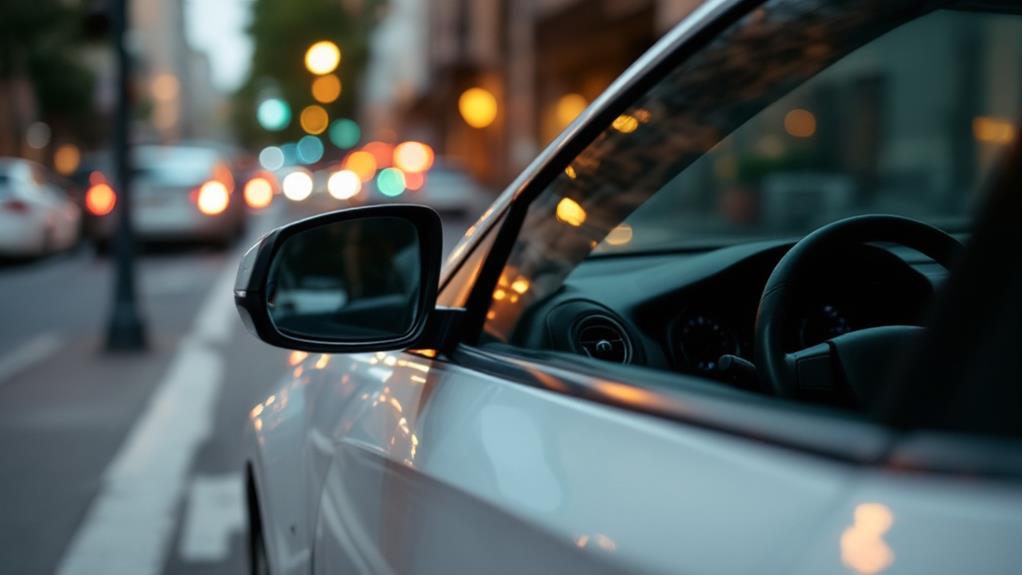
Vigilance is key when safeguarding your parked vehicle on the street. To deter theft and protect your car from environmental damage, take proactive measures. Install a steering wheel lock to prevent thieves from turning the wheel, and use a wheel clamp to immobilize one of your vehicle's wheels. These visible deterrents make your car less appealing to potential thieves.
For keyless entry vehicles, use a Faraday bag to block key fob signals and avoid unauthorized access. When you park, make sure to leave enough space for another car to park comfortably. This consideration helps maintain good relationships with other drivers and reduces the risk of accidental damage.
To protect your vehicle from environmental hazards:
- Keep cleaning materials on hand for quick removal of bird droppings or tree sap
- Invest in a snow cover or blanket for protection against hail or heavy snowfall
- Avoid parking under trees or near construction sites when possible
Exiting Your Parking Spot Safely
Exiting a street parking spot safely involves three key steps. First, guarantee you're ready to leave by adjusting your mirrors, fastening your seatbelt, and starting your engine. Next, carefully observe your surroundings, paying close attention to cars driving by and pedestrians on the sidewalk. Use your mirrors and turn your head to check for any approaching vehicles or cyclists.
Second, signal your intention to exit by turning on your indicator lights. This alerts other drivers to your planned movement and gives them time to adjust their speed or position. Wait for an open space in traffic before proceeding. If visibility is limited, you may need to exit slowly to allow other drivers to see you.
Maintaining Awareness of Pedestrians

Once you've safely exited your parking spot, your focus must shift to the pedestrians around you. Parking lots and street-side spaces are high-traffic areas for both vehicles and people on foot. It might seem like a good idea to always park close to your destination, but this can increase the risk of pedestrian encounters.
As you traverse through these areas, remember to:
- Slow down and stay alert
- Yield to pedestrians, especially in crosswalks
- Make eye contact with people walking nearby
Treat every corner like a stop sign when it comes to pedestrian safety. Be prepared to brake suddenly if someone steps into your path unexpectedly. Avoid distractions that could compromise your ability to spot and react to pedestrians. This includes putting away your phone, adjusting the radio before you start driving, and keeping your eyes on your surroundings.
Handling Parking Disputes Gracefully
Despite your best efforts, parking disputes can sometimes arise. As a responsible driver, it's crucial to handle these situations with grace and civility. When confronted with a parking disagreement, remain calm and avoid escalating the conflict. Remember that every driver faces challenges in crowded parking areas, and a little understanding can go a long way.
If you find someone parked too close to your vehicle, resist the urge to leave an angry note or retaliate. Instead, try to maneuver your car carefully to avoid damage. In cases where you're blocked in, politely ask nearby businesses or residents if they know the owner of the offending vehicle. If all else fails, contact local authorities for assistance.
When you're the one at fault, apologize sincerely and offer to make it right. If you've accidentally taken someone else's spot, move your car promptly. Be willing to compromise and find solutions that work for both parties. By approaching parking disputes with patience and respect, you'll make it easier for everyone to manage the challenges of street parking. Remember, a little courtesy can transform a potentially heated situation into a positive interaction.
